Course Snack or main course Serving temperature Hot | ||
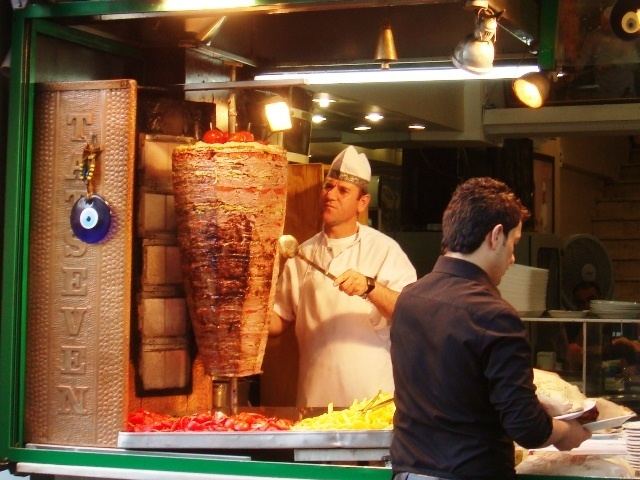 | ||
Created by Ottomans (dates to 18th century) Similar | ||
Istanbul street food iskender kebab doner kebab with yogurt turkey street food
Döner kebab (/ˈdɒnər kəˈbæb/, /ˈdoʊnər/; Turkish: döner or döner kebap, [døˈnɛɾ ˈcebɑp], in English often spelled doner or donner) is a type of Turkish kebab, made of meat cooked on a vertical rotisserie. Similar dishes cooked on a vertical rotisserie are the Arab shawarma, Greek gyros, and Mexican Al pastor.
Contents
- Istanbul street food iskender kebab doner kebab with yogurt turkey street food
- Istanbul street food doner kebab be ikta karadeniz d ner turkey street food
- History
- Etymology
- Dner in Turkey
- Armenia
- Azerbaijan
- Japan
- South Korea
- Vietnam
- Austria
- Belgium
- Finland
- France
- Germany
- Netherlands
- United Kingdom
- Canada
- Mexico
- United States
- Australia
- Health concerns
- References
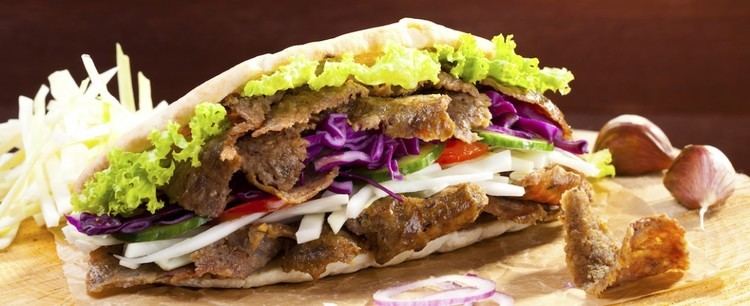
Seasoned meat stacked in the shape of an inverted cone is turned slowly on the rotisserie, next to a vertical cooking element. The outer layer is sliced vertically into thin shavings as it cooks.
The sliced meat of a döner kebab may be served on a plate with various accompaniments, stuffed into a pita or other type of bread as a sandwich, or wrapped in a thin flatbread such as lavash or yufka, known as a Dürüm. Since the early 1970s, the sandwich or wrap form has become popular around the world as a fast food dish sold by kebab shops, and is often called simply "a kebab". The sandwich generally contains salad or vegetables, which may include tomato, lettuce, cabbage, onion with sumac, fresh or pickled cucumber, or chili, and various types of sauces.
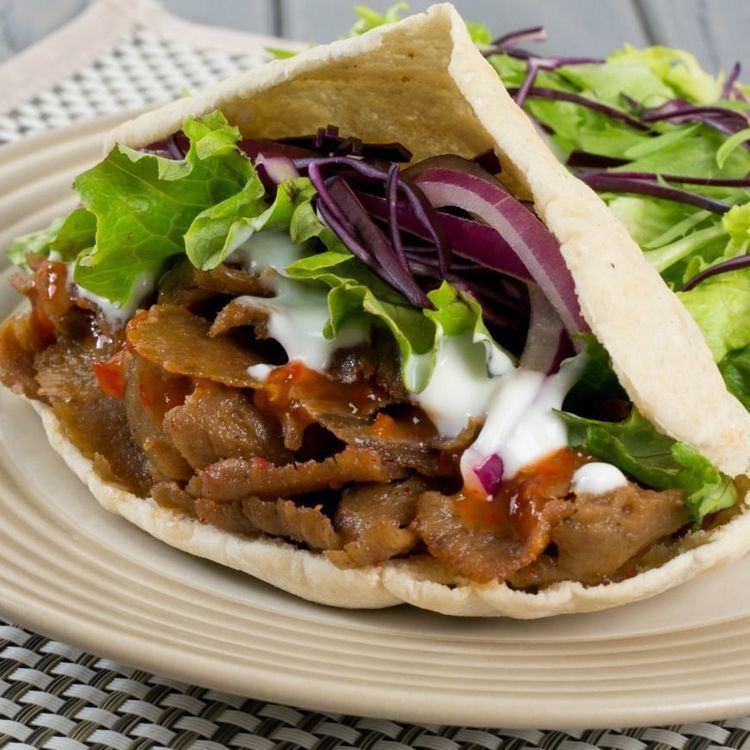
Istanbul street food doner kebab be ikta karadeniz d ner turkey street food
History
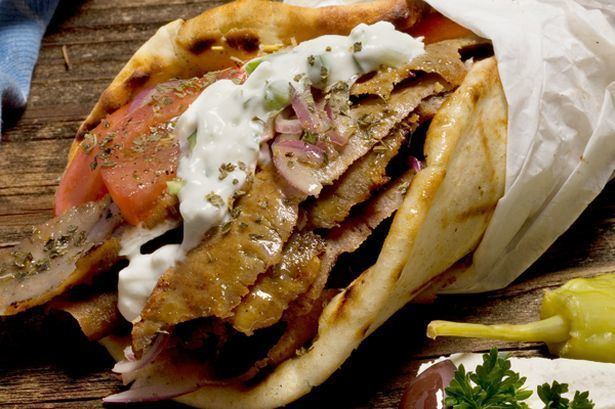
Before taking its modern form, as mentioned in Ottoman travel books of the 18th century, the döner used to be a horizontal stack of meat rather than vertical, like the cağ kebabı of Erzurum. Grilling meat on horizontal skewers has an ancient history in the Eastern Mediterranean, but it is unknown when slices of meat, rather than chunks, were first used.
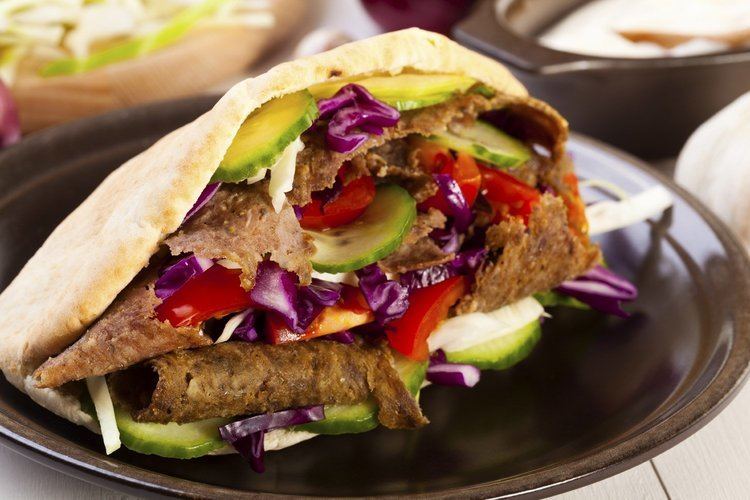
In his own family biography, İskender Efendi of 19th century Bursa writes that "he and his grandfather had the idea of roasting the lamb vertically rather than horizontally, and invented for that purpose a vertical mangal". Since then, Hacı İskender has been considered the inventor of Turkish döner kebap, though he might have been preceded by Hamdi Usta from Kastamonu around 1830.
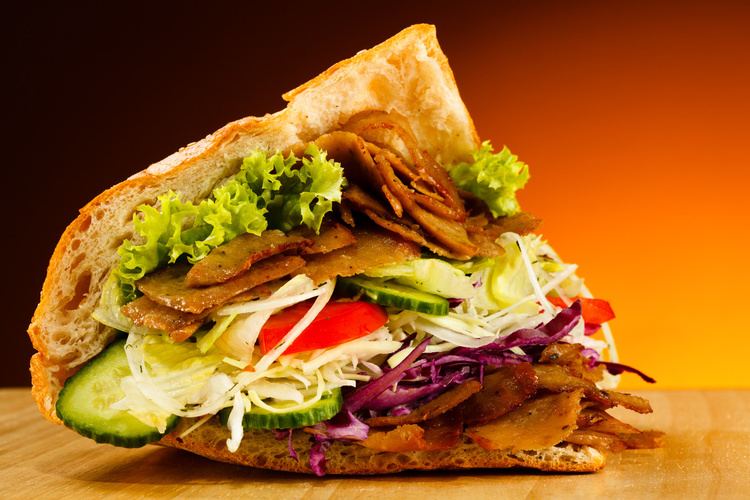
With time, the meat took a different marinade, got leaner, and eventually took its modern shape. It was not until a century later, that döner kebab was introduced and popularized in Istanbul, most famously by Beyti Güler. His restaurant, first opened in 1945, was soon discovered by journalists and began serving döner and other kebab dishes to kings, prime ministers, film stars and celebrities. It has been sold in sandwich form in Istanbul since at least the mid-1960s.
The döner kebab, and its derivatives shawarma and gyros, served in a sandwich, came to world-wide prominence in the mid to late 20th century. The first doner kebab shop in London opened in 1966, while Greek-style gyros was already popular in Greece and New York City in 1971.
In Germany the döner kebab was popularized by Turkish guest workers in the early 1970s with a center in Berlin. The dish developed there from its original form into a distinctive style of sandwich with abundant salad, vegetables, and sauces, sold in large portions at affordable prices, that would soon become one of the top-selling fast food and street food dishes in Germany and much of Europe, and popular around the world.
Etymology
The English word kebab comes from the Arabic: كَبَاب (kabāb), partly through Urdu, Persian and Turkish. It may refer to a number of different kebab dishes made with roasted or grilled meat. Döner is a Turkish word, from dönmek ("to turn" or "to rotate"). It is sometimes spelled döner kebap, the Turkish spelling, and it literally means "rotating roast". In English, it may also be spelled "doner", "donar", "donair" (in Canada) or sometimes "donner". In German, it is spelled Döner Kebab, which can also be spelled Doener Kebab if the ö character is not available; the sandwich is often called ein Döner. Particularly in British English, a döner kebab sandwich may be referred to simply as "a kebab". In Greece, it was originally called döner (Greek: ντονέρ) but later came to be known as gyros, from γύρος ("turn"), a calque of the Turkish name. The Arabic name شاورما (shāwarmā) derives from another Turkish word, çevirme, also meaning "turning". Persians refer to it as "kebab torki".
Döner in Turkey
There are many variations of döner in Turkey:
Armenia
In Armenia Ġarsi khorovats, šaurma or in the Armenian diaspora, "Tarna" (literally, "it turns"); it is usually lamb, pork or chicken on a vertical rotisserie, sliced and wrapped in lavaş, served with tahini, yogurt or garlic sauce and with a side dish of pickled vegetables or tourshi.
Azerbaijan
In Azerbaijan, döner kebab (Azerbaijani: dönər), served similarly to the European style of sandwich wrapped in lavaş (flatbread) or in çörәk (bread, including tandoor bread), is one of the most widespread fast foods. It is usually made with әt (meat, essentially lamb or mutton), but sometimes toyuq (chicken).
Japan
In Japan, döner kebabs are now common, especially in Tokyo. They are predominantly made of chicken but occasionally beef, and called simply "kebab". The toppings include shredded lettuce or cabbage, usually with a choice of sauces such as Thousand Islands, spicy, and garlic, and often sliced tomato.
South Korea
Döner kebab is available throughout much of Seoul, particularly in the foreigner-dominated neighborhood of Itaewon. The kebabs sold at street carts are typically made from chicken rather than lamb, and served in a tortilla or a flatbread; at permanent takeaways a choice of chicken or lamb is almost always offered, together with the occasional option of another type of bread such as a leavened roll.
Vietnam
Döner kebab is increasingly becoming popular in Vietnam. Throughout Hanoi and Ho Chi Minh City many döner kebab stalls can be found. Bánh mỳ Döner Kebab, the Vietnamese version of the döner kebab, has some fundamental differences with the original döner kebab. First of all, pork is used instead of beef and lamb. Second, the meat is served in a Vietnamese baguette. Thirdly, the meat is topped with sour vegetables and chili sauce.
Austria
Döner kebab shops can be found in all cities across Austria. Kebabs (often referred to as "Döner") outsell burgers or the traditional Würstel (sausage).
Belgium
Döner kebab restaurants and food stands can be found in almost all cities and smaller towns in Belgium, where they are known as dürüm when served in a wrap. The variety served is similar to that of Germany and the Netherlands. However, it is not uncommon to see döner served with French fries, often stuffed into the bread itself (similar to the German "Kebab mit Pommes"). Many different sauces are typically offered, including plain mayonnaise, aioli, cocktail sauce, sambal oelek or harissa paste, andalouse sauce, "américaine" sauce and tomato ketchup or curry ketchup. Another basic ingredient of the typical Belgian döner kebab is two or three green, spicy, Turkish peppers.
Finland
In Finland, döner kebabs have gained a lot of popularity since Turkish immigrants opened restaurants and imported their traditional food. Kebabs are generally regarded as fast food, often served in late-night restaurants also serving pizza, as well as shopping malls. There are over 1000 currently active restaurants that serve kebab foods in Finland, making one kebab restaurant for every 5000 people in mainland Finland.
France
Most kebab shops (themselves known simply as kebabs) are generally run by North African immigrants in France. The basic kebab consists of either "pain de maison" (Turkish soft bread) or "pain arabe" (unleavened flatbread) stuffed with grilled lamb shavings, onions and lettuce, with a choice of sauce from sauce blanche (yogurt sauce with garlic and herbs), harissa (spicy red sauce originally from North Africa), ketchup, or several others. Kebabs are usually served with french fries, often stuffed into the bread itself. In Paris, this variation is called Sandwich grec ("Greek sandwich"). Other variations include beef, turkey, chicken, veal, and replacing the Turkish bread with pita bread or baguette.
Germany
In Germany, the first claim to the invention of döner kebab dates to 1969 when an immigrant started to sell the Iskender Kebap in Reutlingen. However the Association of Turkish Döner Producers in Europe (ATDID) connects the introduction of döner kebap the stand of Turkish guest worker Kadir Nurman at Bahnhof Zoo in 1972 which is a location to help establish the dish as a fast food option. While the claims of multiple persons to have "invented" the döner may be hard to prove, the further development of döner kepab is connected to the city of Berlin.
The first döner kebap as it was served at Berlin did only contain meat, onions and a bit of salad. It developed into a dish with abundant salad, vegetables, and a selection of sauces to choose from. Even orders in Turkish language in Berlin will ask for the hot sauce with the German word "scharf" flagging the hybrid nature of the Berlin style of döner kepab. This variation along with pita bread has influenced the style of döner kebap in Germany and in other nations. A survey shows that the people in Berlin consider the döner kepab to be the characteristic food of the city.
Annual sales of döner kebabs in Germany amounted to €2.5 billion in 2010. Beef or veal, and chicken, are widely used instead of the more expensive lamb. Turkey ("Truthahn") and vegetarian versions are becoming increasingly popular.
Tarkan Taşyumruk, president of the Association of Turkish Döner Producers in Europe (ATDID), provided information in 2010 that, every day, more than 400 tonnes of döner kebab meat is produced in Germany by around 350 firms. At the same ATDID fair, Taşyumruk stated that, "Annual sales in Germany amount to €2.5 billion. That shows we are one of the biggest fast-foods in Germany." In many cities throughout Germany, döner kebabs are at least as popular as hamburgers or sausages, especially with young people.
In 2011 there were over 16,000 establishments selling döner kebabs in Germany, with yearly sales of €3.5 billion.
Netherlands
Döner kebab is available in the Netherlands. As a snack, it is usually served in or with a pita as a "broodje döner" (döner sandwich) with lettuce, onion, tomato slices and sauces, mainly garlic and sambal. The Kapsalon, a dish made with döner meat, french fries, cheese, and salad, originated in Rotterdam.
United Kingdom
Introduced by Turkish immigrants, the döner kebab with salad and sauce is a very popular dish in the United Kingdom, especially after a night out.
Canada
A variation known as "donair" was introduced in Halifax, Nova Scotia, Canada, in the early 1970s. Peter Gamoulakos migrated to Canada in 1959. When he failed in his attempt to sell traditional gyros, Gamoulakos adapted the dish to local tastes. He substituted beef for lamb and created a sweet sauce known as "donair sauce". Gamoulakos created the donair in 1973. In 2015 Halifax named donair the official food of the city.
Mexico
Al pastor is a variation of döner kebab via Lebanese shawarma. Literally "in the style of the shepherd", it references the lamb often used in shawarma, though it is normally made with pork.
United States
Döner kebabs have been available in Turkish restaurants in the United States since at least 1985, when a pair of restaurants in the Washington, D.C. suburbs offered the dish. By the late 1990s, if not earlier, it had been served in two or more Turkish establishments in New York City. In recent years a number of restaurants and food trucks specializing in döner kebab have opened in various parts of the country; a substantial percentage are owned by German immigrants. Verts Mediterranean Grill, an Austin-based döner kebab chain with locations mainly in Texas, has become the second-largest döner kebab chain in the world.
Australia
With a multicultural population, the doner kebab in Australia competes with the Greek gyros and the Lebanese shawarma. Kebab sellers are subject to strict government Food safety regulations.
Health concerns
Döner kebab is popular in many countries in the form of fast food, often as an end to a night out when preceded by the consumption of alcohol. Health concerns regarding döner kebab, including the hygiene involved in overnight storage and re-heating of partially cooked meat, its quality, as well as high salt, fat, and calorie levels, have been reported in the media. Lean meat, wholemeal bread, and salad, can be considered healthy eating choices, but large amounts of oil-based sauces, added salt, fatty meat, and overly large portions, may contribute to significant health risks.
Some investigations have found poor-quality ingredients in döner kebab meat, or meat types other than what was advertised. Food safety regulations in most countries address the dangers of bacteria in undercooked meat of all kinds, sold to the public. Some have guidelines specific to döner kebab handling and preparation. Following several outbreaks of E. coli food poisoning, the Canadian government in 2008 introduced a number of recommendations, including that the meat should be cooked a second time, after being sliced from the rotisserie.
